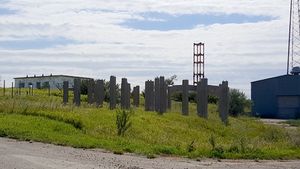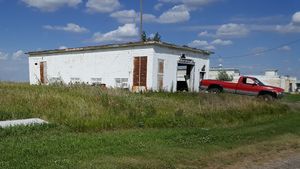Minot Air Force Station
|
Minot Air Force Station (1951-1979) - A Cold War Air Force Radar Station first established as Velva Air Force Station in 1951 near Minot, Ward County, North Dakota. Renamed Minot Air Force Station after the location in 1953. Initially assigned a Permanent ID of P-28, later a Sage ID of Z-28. Abandoned in 1979.
HistoryEstablished in 1951 and became operational in April 1952 as Velva Air Force Station manned by the 786th AC&W Squadron. The station initially had both a Ground-Control Intercept (GCI) and early warning mission. The early warning mission involved tracking and identifying all aircraft entering their airspace while the GCI mission involved guiding Air Force interceptors to any identified enemy aircraft. Controllers at the station vectored fighter aircraft at the correct course and speed to intercept enemy aircraft using voice commands via ground-to-air radio. Initial equipment included the FPS-3 and FPS-5 search radars. On 1 Dec 1953, the site was designated as Minot Air Force Station, North Dakota.   In preparation for SAGE operations, the search radar was upgraded to an FPS-20, a FPS-6 height-finder radar was installed and the SAGE annex for the FST-2 was built in 1958. A second height-finder, a FPS-6B, was installed in 1959. This was the early standard configuration for SAGE sites, one FPS-20 search radar, and two FPS-6 height-finders.
SAGE TransitionThe transition of the manual GCI system to the automated SAGE system began with the installation of the FST-2 coordinate data transmitter and search radar upgrades. The FST-2 equipment digitized the radar returns and transmitted the digital returns to the SAGE direction center. Under the SAGE System, interceptor aircraft were directed to their targets by the direction center computers and controllers, greatly reducing the need for local controllers and equipment at every radar station. The FST-2 was a very large digital system using vacuum tube technology. Over 6900 vacuum tubes were used in each FST-2 requiring 21 air-conditioned cabinets, 40 tons of air conditioning, 43.5 kva of prime power, and usually a large new addition to the operations building. The FST-2B modification added two more cabinets but with newer solid-state (transistor) technology to process coded responses from aircraft transponders. SAGE Operation The site began operation as a SAGE site on 1 Jan 1959, initially feeding data to the Minot SAGE Direction Center DC-19. With the closure of the Minot SAGE Direction Center DC-19 in 1963, control of SAGE operations switched to the Malmstrom SAGE Direction Center DC-20 in Great Falls, Montana on 25 Jun 1963. Minot AFS SAGE operations continued under DC-20 until the site closed in 1979. In 1961 the FPS-20 was upgraded to an FPS-66 and in 1964 a FPS-27 search radar replaced the FPS-66. That same year a FPS-26A replaced a FPS-6 height-finder and the FPS-6B height-finder was upgraded to a FPS-90. In the early 1970s, the vacuum tube FST-2 Coordinate Data Transmitter was replaced with the solid state FYQ-47 Common Digitizer.
Gap FillersMinot AFS was responsible for the maintenance of three remote unattended gap-filler radar sites. The unattended gap filler sites were placed in locations where the main search radar lacked coverage. These sites were equipped with short range FPS-14 or FPS-18 search radars and FST-1 Coordinate Data transmitters that sent digitized radar target data to a SAGE direction center and to the main radar site. Both the radar set and the FST-1 were dual channel to increase site up time. Maintenance teams were dispatched for regularly scheduled maintenance or when fault indicators on the FSW-1 remote monitoring equipment suggested the site had problems. The FSW-1 also allowed remote operation of specific functions such as channel changes for the radar and for the FST-1, it also allowed remote operation of the diesel generators at the gap filler site. The Minot AFS gap-filler radars were located at Niobe, Regan and Alexander, North Dakota. Two additional gap-fillers were planned at Newton and Washburn, North Dakota but were never built.
ClosureMinot AFS and the 786th were deactivated on 1 Jul 1979. The closing ceremonies took place on 29 Jun 1979. Physical Plant      The physical plant of the site was divided into the main site, a cantonment area, a housing area and a radio site. The main site housed the operations buildings, the radar towers, and the backup generators. The cantonment area developed in three areas around the main site. Area 1 housed the recreational structures including the Recreation Hall, Hobby Shops, NCO Club and the telephone building (TELCO). Area 2 housed the Orderly Room, Mess Hall, BOQ and one Enlisted Barracks. Area 3 housed one enlisted barracks, the heating plant, the motor pool and other support buildings. Apart from the main site was a small 27 unit housing area for married personnel. A small trailer park was also located at the rear of the housing area. Like most AC&W radar stations the married housing area probably evolved from an initial 9 units into the final configuration of 27 units. A separate Ground to Air Transmitter/Receiver (GATR) radio site housed the radio equipment for directing aircraft intercepts. Like most AC&W radar sites Minot AFS initially had two separate radio sites, a receiver site and a transmitter site close to the station. With the switch to SAGE a single GATR site was built, situated closer to the Minot SAGE Direction Center DC-19 because the direction center theoretically controlled most missions.

Current StatusAbandoned and now in private hands. As of July 2016 many of the buildings remain intact but in various stages of disrepair and some are in use. Most of the cantonment buildings are still standing. In the main site area, all of the radar towers are gone, leaving only some foundations and supports. The operations building looks completely intact and the SAGE Annex still looks good. The housing area is mixed with some houses looking good while others are deteriorating. Two commercial radio towers are in place at the back of the main site.
See Also:
Sources:
Links: Visited: 7 Aug 2016
| ||||||||||||||||||||||||||||||||||||||||||||||||||||||||||||||||||||||||||||||||||||||||||||||||||||||||||||||||||||||||||||||||||||||||||||||||||||||||||||||||||||||


